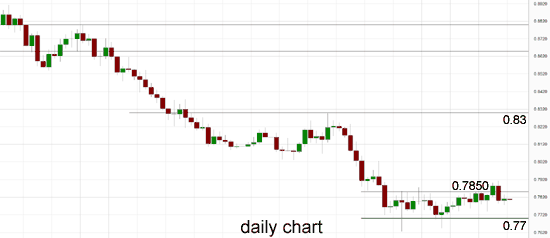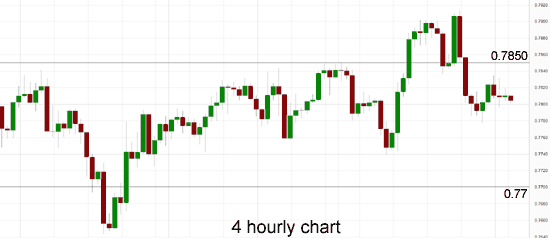AUD/USD for Monday, March 2, 2015
After finally springing to life in the middle of last week, the Australian dollar dropped sharply to close out the week and fall back down below 0.7800 again to more familiar territory below the resistance level at 0.7850. During last week the Australian dollar moved through the resistance at 0.7850 to reach a new four week high around 0.7900. For the last month the Australian dollar has steadied well and traded in a narrow range between support at 0.77 and 0.78, although a couple of weeks ago it rallied higher to a two week high near 0.7850. To start last week it slowly eased back a little from resistance at 0.7850 however it is finally made its way through there. It has enjoyed receiving solid support from the 0.77 level throughout this time. A few weeks ago it rallied a little higher again back towards 0.78 however it then eased back to receive more support from 0.77. Several weeks ago the Australian dollar was on a roller-coaster ride dropping sharply to a new multi-year low below 0.7630 before rallying strongly and moving back up above the 0.77 level and more recently 0.78.
In the second half of January, the Australian dollar fell very sharply and break lower from the trading range that had been established roughly between 0.8050 and 0.8200. Back in mid-January it made numerous attempts at the resistance level at 0.82 only to be sent back often before finally finishing that week moving through this key level. In doing so it was able to reach a one month high near 0.83 before being sold back down again towards 0.82 as the resistance and selling activity above this level kicked in. Over the Christmas / New Year period, the Australian dollar seemed to have been content with trading in a narrow range below the resistance at 0.82, which continues to remain a key level as it is presently provides resistance. The Australian dollar experienced a disappointing November and December moving from resistance around 0.88 down to the new lows recently. For a couple of months from September through to November, the Australian dollar did well to stop the bleeding and trade within a range between 0.8650 and 0.88 after experiencing a sharp decline throughout September which saw it move from close to 0.94 down to below 0.8650.
Back at the beginning of September the Australian dollar showed some positive signs as it surged higher again bouncing off support below 0.93 and reaching a new four week high around 0.94 however that all now seems a distant memory. It seems a long way away now but the Australian dollar reached a three week high just shy of 0.9480 at the end of July after it enjoyed a solid period which saw it surge higher through the resistance level at 0.9425 to the three week around 0.9480, before easing back towards that level. The Australian dollar enjoyed a solid surge higher reaching a new eight month high above 0.95 at the end of June, only to return most of its gains in very quick time to finish out that week. Since the middle of June the Australian dollar has made repeated attempts to break through the resistance level around 0.9425, however despite its best efforts it was rejected every time as the key level continued to stand tall, even though it has allowed the small excursion to above 0.95.
The Reserve Bank of Australia’s (RBA) claim that the Australian dollar is overvalued is not only wrong, it’s disingenuous, according to new research by National Australia Bank. “We’re taking issue with the contention that the RBA continues to repeat that the Australian dollar remains fundamentally overvalued, in particular with relation to the weakness in commodity prices,” Ray Attrill, co-head of FX Strategy at National Australia Bank (NAB), told CNBC. In the RBA’s recent monthly policy statements, the central bank frequently stated that the currency “remains above estimates of its fundamental value, given the significant declines in key commodity prices,” particularly Brent crude’s 40 percent decline over the past six months and a decline in iron ore prices to a six-year low. Fair value, according to RBA governor Glenn Stevens, is 75 U.S. cents – a 4 percent decrease from current levels.
(Daily chart / 4 hourly chart below)


AUD/USD March 1 at 22:40 GMT 0.7804 H: 0.7809 L: 0.7801
AUD/USD Technical
| S3 | S2 | S1 | R1 | R2 | R3 |
| 0.7700 | — | — | 0.7850 | 0.8200 | 0.8650 |
During the early hours of the Asian trading session on Monday, the AUD/USD is easing a little lower back towards 0.78 after finishing last week below the resistance level of 0.7850. Current range: trading right below 0.7800 around 0.7805.
Further levels in both directions:
• Below: 0.7700.
• Above: 0.7850, 0.8200, and 0.8650.
OANDA’s Open Position Ratios
![]()
(Shows the ratio of long vs. short positions held for the AUD/USD among all OANDA clients. The left percentage (blue) shows long positions; the right percentage (orange) shows short positions.)
The long position ratio for the AUD/USD has moved back above 55% as the Australian dollar has moved back below the resistance level at 0.7850. The trader sentiment has shifted to being in favour of long positions.
Economic Releases
- 07:00 UK Nationwide House Prices (Feb)
- 09:00 EU Manufacturing PMI (Feb)
- 09:30 UK BoE – Mortgage Approvals (Jan)
- 09:30 UK BoE – Net Consumer Credit (Jan)
- 09:30 UK BoE – Secured Lending (Jan)
- 09:30 UK CIPS/Markit Manufacturing PMI (Feb)
- 09:30 UK M4 Money Supply (Jan)
- 10:00 EU Flash HICP (Feb)
- 10:00 EU Unemployment (Jan)
- 13:30 CA Current Account (Q4)
- 13:30 US Core PCE Price Index (Jan)
- 13:30 US Personal income & spending (Jan)
- 14:45 US Manufacturing PMI (Feb)
- 15:00 US Construction Spending (Jan)
- 15:00 US ISM Manufacturing (Feb)
Which stock should you buy in your very next trade?
AI computing powers are changing the stock market. Investing.com's ProPicks AI includes 6 winning stock portfolios chosen by our advanced AI. In 2024 alone, ProPicks AI identified 2 stocks that surged over 150%, 4 additional stocks that leaped over 30%, and 3 more that climbed over 25%. Which stock will be the next to soar?
Unlock ProPicks AI